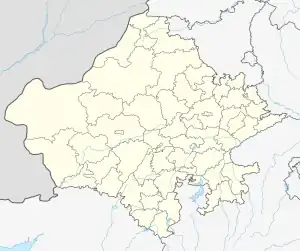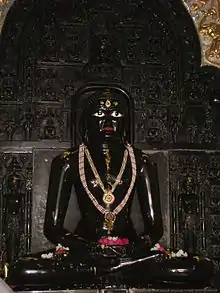Kesariyaji
Kesariyaji Tirth or Rishabhdeo Jain temple is a Jain temple located in Rishabhdeo town of Udaipur District of Indian state of Rajasthan. The temple is considered an important pilgrimage center by both Digambara and Śvētāmbara sect of Jainism.[1][2][3]
| Kesariyaji | |
|---|---|
.jpg.webp) Shree Kesariyaji Tirth | |
| Religion | |
| Affiliation | Jainism |
| Sect | Digambara and Śvētāmbara |
| Deity | Rishabhanatha |
| Festivals | Mahavir Janma Kalyanak |
| Location | |
| Location | Rishabhdeo, Udaipur District, Rajasthan |
 Location within Rajasthan | |
| Geographic coordinates | 24°04′35″N 73°41′22″E |
| Architecture | |
| Creator | Rawal Khuyan |
| Date established | 874 CE |
| Specifications | |
| Temple(s) | 5 |
| Materials | Marble, limestone |
| Website | |
| www | |
History
The temple was constructed in 874 CE (VS 931) during the reign of Rawal Khuyan, the ruler of Mewar.[4] The temple received patronage from rich merchants since its situated on an important trade route from the coast to the state of Mewar. An inscription dated back to 1422 CE, indicates repairs and renovations were made to the temple during the 14th to 15th centuries.[5] Since 14th century, there has been a history of conflict over control of this temple between members of Digambara, Śvētāmbara and Hindus community based on relation with rulers of Mewar.[6][7][3]
Acharya Shantisagar was initiated as a kshullak at Kesariyaji in front of the image of Rishabhanatha in 1922 CE.[8]
Discovery of idol
The main idol of the temple, popularly known as Kesariyaji, is a 1.05 metres (3 ft 5 in) black stone idol of Adinatha or Rishabhanatha in lotus position. [4]
The iconic idol of Lord Rishabhanatha, the principal deity of the pilgrimage temple, was found during an excavation. A Bhil dairy farmer noticed that one of his cows was always dry of milk. When cow belonging used to pour out its milk every day upon a mound near Chandanpur village. It was surprising for the owner of that cow and the villagers. They excavated the mound. The villagers dedicated themselves to building a small hut over the idol where the idol was found. The place is now known as paglia-ji or chharan chatri.[9]
Architecture
The temple has an ornate architecture.[10] The temple has a large domical structure as the principal shrine with domical 52 sub-shrine along the axis of principal shrine.[5] In the parikrama path there are idols of Charbhuja (four armed) Vishnu, Parshvanatha, Somnath Shiva. The pillared porch features Nava chowki (nine seats) with idols of Ajitnatha, Sambhavanatha, Sumatinatha and Neminatha.[4] The shafts of the pillars are richly carved. The Shikara of the temple is crowned by amalaka.[11] The temple also features a richly carved torana.[4]
About the temple

The temple is considered an important pilgrimage center by both Digambara and Śvētāmbara sect of Jainism and Hindus.[1][3][12] The mulnayak of the temple is a 1.05 metres (3 ft 5 in) black stone idol of Rishabhanatha, revered by both Vaishnavas and Jains.[4][2] Kesariyaji is the name of Rishabhanatha idol inside the temple. The name is derived from the instance of a man of offering kesar (transl. saffron[13]) equal to his son's weight when his wish of having a child is fulfilled.[14] According to another legend, a Brahmin once threw a coin at idol saying "if you have any strength you will show it me", the coin flew back hit Brahmin head.[15]
The idol is considered miraculous and according Jain belief praying to the idol fulfills the wishes of devotees.[16][17] The saffron and garland is profusely applied to the idol for worship.[15][18][19] The replicas of Kesariyaji Rishabhanatha is popular among Śvētāmbara murtipujaka. According to Jain belief, worshipping these local replication idols allow them to directly worship to the original idol.[20] In front the principal shrine there is an idol of Marudevi, mother of Rishabhanatha, seated on an elephant.[5]
The temple also has a dharamshala equipped with all modern facilities, including bhojanalaya (a restaurant). There is a temple known as Pagliyaji, housing footprints of Rishabhanatha inside a chhatri.[5]
Conflicts
The nature of the temple has been an issue between Digambara, Śvētāmbara and Hindus.[6] The Śvētāmbara murtipujaka Acharya Tirthavijaya endeavoured to free Kesariyaji from the control of Brahmin community and returned to Jain.[3] According to the court judgement, idols are worshipped as per Digambara tradition in the morning and as per Śvētāmbara tradition in the evening.[21] The temple also houses images of Hindu deities. The temple is also visited by members of the Bhil community. They only worship Hindu idols except for the Rishabhanatha idol. However, Rishabhanatha is worshipped as a Kala-ji or Bhomia, a protective deity of land and soil.[22][23][24]
Fair
A fair is organised here on the birth anniversary of Rishabhanatha and draws a huge number of devotees.[4][25] A rath yatra is organised from the main temple to Pagliyaji temple.[5]
See also
References
Citations
- Shah 1987, p. 115.
- Crooke 1896, pp. 104–105.
- Wiley 2009, p. 233.
- Department of Devasthan.
- Mehta 1970, p. 158.
- Cort 2000, p. 336.
- Carrithers & Humphrey 1991, p. 215.
- Wiley 2009, p. 192.
- Carrithers & Humphrey 1991, p. 207.
- IGNCA, p. 1.
- IGNCA, pp. 1–2.
- Kuiper 2010, p. 159.
- Kumar 1984, p. 81.
- Kelting 2001, p. 230.
- Carrithers & Humphrey 1991, p. 210.
- Cort 2001, p. 233.
- Weisgrau & Henderson 2016, p. 178.
- Mehta 1970, p. 157.
- Kumar 1984, p. 19.
- Cort 2010, p. 186.
- Carrithers & Humphrey 1991, p. 223.
- Carrithers & Humphrey 1991, p. 224.
- Panikar 2010, p. 316.
- Shrimali 2017, p. 14.
- Carrithers & Humphrey 1991, p. 213.
Books
- Carrithers, Michael; Humphrey, Caroline (4 April 1991). The Assembly of Listeners: Jains in Society. Cambridge University Press. ISBN 9780521365055.
- Cort, John E. (2010). Framing the Jina: Narratives of Icons and Idols in Jain History. Oxford University Press. ISBN 978-0-19-538502-1.
- Cort, John E. (2001). Jains in the World: Religious Values and Ideology in India. Oxford University Press. ISBN 978-0-19-803037-9.
- Crooke, William (1896). The Tribes and Castes of the North-western Provinces and Oudh. Vol. 4. Office of the superintendent of government printing.
- Kelting, Mary Whitney (2001). Singing to the Jinas: Jain Laywomen, Maṇḍaḷ Singing, and the Negotiations of Jain Devotion. Oxford University Press. ISBN 9780195140118.
- Kuiper, Kathleen (1 April 2010). The Culture of India. Britannica Educational Publishing. ISBN 9781615302031.
- Kumar, Pramod (1984). Folk Icons and Rituals in Tribal Life. Abhinav Publications. ISBN 9788170171850.
- Mehta, Jodh Sinha (1970). Abu to Udapiur. Motilal Banarsidass. ISBN 9788120829848.
- Panikar, Agustin (2010). Jainism: History, Society, Philosophy and Practice. Lala Sunder Lal Jain research series. Vol. 24. Delhi: Motilal Banarsidass. ISBN 978-81-208-3460-6.
- Shah, Umakant Premanand (1987). Jaina-rūpa-maṇḍana: Jaina iconography. Delhi: Abhinav Publications. ISBN 81-7017-208-X.
- Weisgrau, Maxine; Henderson, Carol (23 March 2016). Raj rhapsodies: tourism, heritage and the seduction of history. New Directions in Tourism Analysis. Routledge. ISBN 978-1-3170-7161-7.
- Wiley, Kristi L. (2009). The A to Z of Jainism. Vol. 38. Scarecrow Press. ISBN 978-0-8108-6337-8.
Web
- Cort, John E. (2000). "'Intellectual Ahiṃsā' Revisited: Jain Tolerance and Intolerance of Others". Philosophy East and West. 50 (3): 324–347. JSTOR 1400177. Retrieved 15 May 2022.
- Shrimali, Krishna Mohan (2017). "The Formation of Religious Identities in India". Social Scientist. 45 (5): 3–27. JSTOR 26380477. Retrieved 15 May 2022.
- "Mandir Shri Rishabhdev Ji". Department of Devasthan, Government of Rajasthan.
- IGNCA. "Digmber Jain Mandir" (PDF). Indira Gandhi National Centre for the Arts.
External links
![]() Media related to Rishabhdeo Jain temples at Wikimedia Commons
Media related to Rishabhdeo Jain temples at Wikimedia Commons